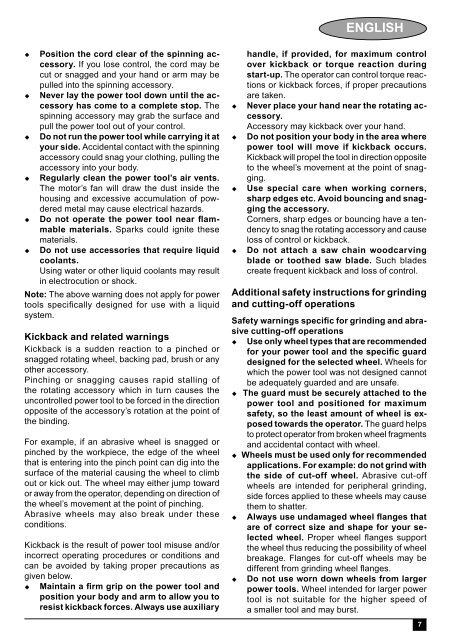BlackandDecker Smerigliatrice Angolare Piccola- Cd105 - Type 4 - Instruction Manual (Europeo Orientale)
BlackandDecker Smerigliatrice Angolare Piccola- Cd105 - Type 4 - Instruction Manual (Europeo Orientale)
BlackandDecker Smerigliatrice Angolare Piccola- Cd105 - Type 4 - Instruction Manual (Europeo Orientale)
Create successful ePaper yourself
Turn your PDF publications into a flip-book with our unique Google optimized e-Paper software.
ENGLISH<br />
Position the cord clear of the spinning accessory.<br />
If you lose control, the cord may be<br />
cut or snagged and your hand or arm may be<br />
pulled into the spinning accessory.<br />
Never lay the power tool down until the accessory<br />
has come to a complete stop. The<br />
spinning accessory may grab the surface and<br />
pull the power tool out of your control.<br />
Do not run the power tool while carrying it at<br />
your side. Accidental contact with the spinning<br />
accessory could snag your clothing, pulling the<br />
accessory into your body.<br />
Regularly clean the power tool’s air vents.<br />
The motor’s fan will draw the dust inside the<br />
housing and excessive accumulation of powdered<br />
metal may cause electrical hazards.<br />
Do not operate the power tool near flammable<br />
materials. Sparks could ignite these<br />
materials.<br />
Do not use accessories that require liquid<br />
coolants.<br />
Using water or other liquid coolants may result<br />
in electrocution or shock.<br />
Note: The above warning does not apply for power<br />
tools specifi cally designed for use with a liquid<br />
system.<br />
Kickback and related warnings<br />
Kickback is a sudden reaction to a pinched or<br />
snagged rotating wheel, backing pad, brush or any<br />
other accessory.<br />
Pinching or snagging causes rapid stalling of<br />
the rotating accessory which in turn causes the<br />
uncontrolled power tool to be forced in the direction<br />
opposite of the accessory’s rotation at the point of<br />
the binding.<br />
For example, if an abrasive wheel is snagged or<br />
pinched by the workpiece, the edge of the wheel<br />
that is entering into the pinch point can dig into the<br />
surface of the material causing the wheel to climb<br />
out or kick out. The wheel may either jump toward<br />
or away from the operator, depending on direction of<br />
the wheel’s movement at the point of pinching.<br />
Abrasive wheels may also break under these<br />
conditions.<br />
Kickback is the result of power tool misuse and/or<br />
incorrect operating procedures or conditions and<br />
can be avoided by taking proper precautions as<br />
given below.<br />
Maintain a firm grip on the power tool and<br />
position your body and arm to allow you to<br />
resist kickback forces. Always use auxiliary<br />
<br />
<br />
<br />
<br />
handle, if provided, for maximum control<br />
over kickback or torque reaction during<br />
start-up. The operator can control torque reactions<br />
or kickback forces, if proper precautions<br />
are taken.<br />
Never place your hand near the rotating accessory.<br />
Accessory may kickback over your hand.<br />
Do not position your body in the area where<br />
power tool will move if kickback occurs.<br />
Kickback will propel the tool in direction opposite<br />
to the wheel’s movement at the point of snagging.<br />
Use special care when working corners,<br />
sharp edges etc. Avoid bouncing and snagging<br />
the accessory.<br />
Corners, sharp edges or bouncing have a tendency<br />
to snag the rotating accessory and cause<br />
loss of control or kickback.<br />
Do not attach a saw chain woodcarving<br />
blade or toothed saw blade. Such blades<br />
create frequent kickback and loss of control.<br />
Additional safety instructions for grinding<br />
and cutting-off operations<br />
Safety warnings specific for grinding and abrasive<br />
cutting-off operations<br />
Use only wheel types that are recommended<br />
for your power tool and the specific guard<br />
designed for the selected wheel. Wheels for<br />
which the power tool was not designed cannot<br />
be adequately guarded and are unsafe.<br />
The guard must be securely attached to the<br />
power tool and positioned for maximum<br />
safety, so the least amount of wheel is exposed<br />
towards the operator. The guard helps<br />
to protect operator from broken wheel fragments<br />
and accidental contact with wheel.<br />
Wheels must be used only for recommended<br />
applications. For example: do not grind with<br />
the side of cut-off wheel. Abrasive cut-off<br />
wheels are intended for peripheral grinding,<br />
side forces applied to these wheels may cause<br />
them to shatter.<br />
Always use undamaged wheel flanges that<br />
are of correct size and shape for your selected<br />
wheel. Proper wheel fl anges support<br />
the wheel thus reducing the possibility of wheel<br />
breakage. Flanges for cut-off wheels may be<br />
different from grinding wheel fl anges.<br />
Do not use worn down wheels from larger<br />
power tools. Wheel intended for larger power<br />
tool is not suitable for the higher speed of<br />
a smaller tool and may burst.<br />
7
















